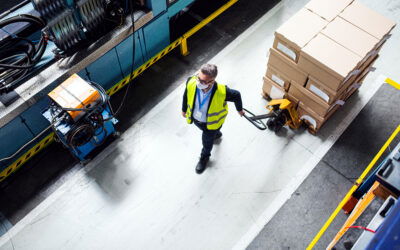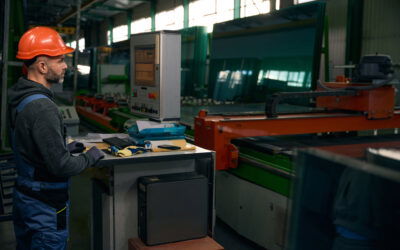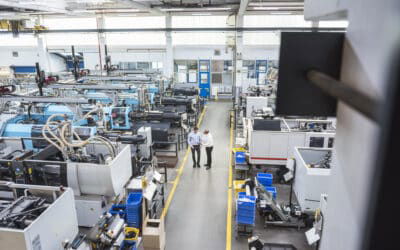French and European industry, between crisis and shortage?
La pandémie de COVID-19 a bouleversé l’économie mondiale. Dans les livres d’histoire, on pourra un jour lire l’arrêt total de la production mondiale. Dans le même temps, les besoins en masques, en matériel médical et en produits numériques ont explosé. Tout cela a conduit à une pénurie mondiale. C’était en mai 2020, et c’est encore dans tous les esprits. Un an après, où en sommes-nous ?
An explosion in demand driven by similar needs
In France, Europe and around the world, we are all following the same guidelines. It’s the age of digital everything. But it’s also the time for a real upturn in production. The health crisis has halted or slowed down many industries. This has created two problems. We now need to get manufacturing going again, and that can sometimes be complicated. But above all, it has to be stronger and faster! In fact, the loss of earnings and the demand that is making up for lost time are two factors that are driving strong demand.
Today, all countries have the same needs. They need logistics to import and export, raw materials to supply heavy industry, and spare parts to assemble consumer products such as vehicles and electronics.
As demand outstrips supply, prices rise, but money is not the only factor. Government policy also comes into play.
Shortage of components in production-ready sectors
Whereas last summer, just a few weeks after the first wave of the epidemic, most industries had resumed production, many production sites are at a standstill right now. It’s not a question of having staff on hand. The machines can work, they are capable of it. But which components should be assembled? Europe is suffering from a shortage of electronic components. Semiconductors manufactured for the most part in Taiwan. Semiconductors, but what for?
These electronic chips are everywhere, in our cars, smartphones, printers, computers and more. The confinements have caused demand for computer hardware to explode during 2020. It’s a record year for computer sales, for example, with a 10% increase over 2019. Global teleworking is the source.
This shortage of electronic cards is causing the temporary stoppage of several automotive lines, notably at Renault, with weeks of closure at Flins, and the same at PSA’s Sochaux and Rennes plants. This is one of the limits of just-in-time production. In fact, Toyota put its North American plants on hold last month.
The automotive sector is not the only one affected. Sony has announced that it will not be able to meet its sales targets for the Playstation 5 in 2021, for no other reason than a shortage of these chips. We’re talking about the brand’s flagship product.
A shortage of raw materials?
Raw materials are suffering the same fate, with growing demand and falling supply. This is particularly true of steel, copper and aluminium. Here again, demand is increasing worldwide, despite the fact that mines have come to a halt over the past year. Today, the only way out is an increase in prices. At the beginning of the year, French giant Nexans published a comparison of prices between July 2020 and February 2021. Over this period, the price of a tonne of steel rose by 106%, tin by 53% and copper by 50%. PVC, meanwhile, has seen inflation rise by 115%.
The plastics industry has not been spared. A combination of circumstances has also affected this sector, with shortages of polypropylene. This widely-used plastic is used in particular for the pipette cones required for PCR tests. What are the reasons for this shortage? The factories shut down last May, but not only that. The cold snap that hit Texas in February led to the closure of several petrochemical sites there. Power cuts were to blame. The particularly violent storms along the Gulf Coast in 2020 also had their part to play. This was followed by record price rises for all the plastic components produced by these plants: polypropylene, polyethylene, PVC, etc.
Once again, the automotive industry is affected, as are paint manufacturers and the construction industry. And if all that wasn’t enough, in addition to the shortage of materials, we are cruelly lacking in intercontinental transport solutions.
International logistics overloaded
The fall in world production last year prompted carriers to reduce their supply. They reduced their transport capacity by around 30%. They were not prepared for an increase in demand. In fact, consumers have spent more money on goods over the last 12 months than ever before. This is due to the closure of restaurants, bars and the impossibility of travelling.
It’s no secret that Asia is the world’s leading exporter of consumer goods. When demand exploded, the reduction in the number of containers was ill-advised. What’s more, a lot of transport capacity was absorbed by the transpacific axis, represented by the Americas in general. Today, traffic is still not back to normal, and the price of a 20-foot container has risen from $1,000 in July 2020 to over $4,000 today.
The consequences are far-reaching, with supply disruptions for some French and European customers. We’re talking here about factories sourcing on the Asian market, as is the case for the electric bicycle market. This is due to overbooking of containers, leading to cancellations and longer booking times, not to mention the general delay caused by the ‘Evergreen’, which blocked the Suez Canal for several days.
Air and rail carriers are rubbing their hands, but so are those in the maritime sector. The shortage of containers has pushed up prices, and therefore their margins. No figures have been announced here, but Jerome Powell, President of the Fed (US Central Bank) is reassuring: ‘We think the supply chain will adapt and become more efficient, it could take a year, but it will happen’.
But how do you combat these shortages?
It’s hard to find a turnkey solution, but a lot of people are working on it. As far as ores are concerned, we have a few mines in Europe, dominated by Sweden and Finland, but they only account for a very small proportion of global production. In fact, in 2017, the EU produced only 9% of its mineral consumption. This will not be enough. It is against this backdrop that we must keep our fingers crossed that we do not enter into diplomatic conflict with the producer countries. This could be fatal for many French structures. The cards are in the government’s hands.
At the same time, another area of work is the search for technologies that use fewer materials and cleaner processes. While we await these new technologies, the biggest benefit in terms of available materials remains recycling. By reusing materials, we can make progress towards reducing imports. This won’t make us self-sufficient, but it can help us move forward… if the recycling takes place in the country.
La pandémie de COVID-19 a bouleversé l’économie mondiale. Dans les livres d’histoire, on pourra un jour lire l’arrêt total de la production mondiale. Dans le même temps, les besoins en masques, en matériel médical et en produits numériques ont explosé. Tout cela a conduit à une pénurie mondiale. C’était en mai 2020, et c’est encore dans tous les esprits. Un an après, où en sommes-nous ?





0 Comments